 |
|||||||||||||||||||||||||||||||||||||||||||||||||
|
|||||||||||||||||||||||||||||||||||||||||||||||||
Crop Production |
Major Areas :: Bio-Fuels |
Weather |
|||||||||||||||||||||||||||||||||||||||||||||||
CULTIVATION TECHNIQUES OF JATROPHA (Jatropha curcas) INTRODUCTION: Jatropha curcas is multi purpose non edible oil yielding perennial shrub which originated in tropical America and West Asia. It is commonly known as physic nut or purging nut. Jatropha curcas belongs to the family Euphorbiaceae andhas the tendency to produce latex and animals do not browse the plant. The genus Jatropha has 176 species and distributed throughout the world. Among them, 12 species are recorded in India. The species Jatropha curcas is a promising species with economic seed yield and oil recovery. This is a hardy and drought tolerant crop that can be raised in marginal lands with lesser input. The crop can be maintained for 30 years economically. The life span of the plant is 30 – 40 years. Jatropha produces seeds with oil content of 30 – 40 per cent. The oil can be combusted as fuel without being refined by blending with diesel upto 20 per cent. It burns with clear smoke-free flame. The biofuel has been tested successfully with different diesel engines. The by-products are cake and glycerin. The cake is used as manure. It can also be used as cattle feed after removing toxic substances. Glycerin is used as substrate for the cosmetic industries. The alkaloids such as porpholester, and curcin offer good potential for medicinal use. Medically, it is used for diseases like cancer, piles, snakebite, paralysis, dropsy etc. The husk after decortications can be used as gasifier for heat energy production.The plant flowers a year after planting and the economic yield is obtained from 4th year onwards, and the yield stabilization 5th year onwards. 1. Plantation raised through Direct SowingAfter land preparation, one cubic feet pits are to be made at suitable spacing and three seeds are to be sown in these pits. Upon germination, one well grown seedling per pit is retained and the rest are culled out within 30 days. The culled out seedlings can be used for gap filling.
2.Through Seedling
|
|||||||||||||||||||||||||||||||||||||||||||||||||
 |
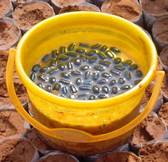 |
Seeds |
Seed treatment |
Seeds may be treated with water soaking or cow dung solution for 12 hours for enhanced germination.
Direct sowing in polybags
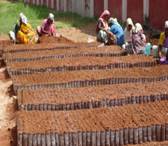 |
 |
Poly bag filling |
Watering one seed per polybag |
Seeds are directly sown in poly bags of 10 x 20 cm size filled with red soil, sand and farmyard manure in the ratio of 2:1:1 respectively.
Seedlings raised through motherbed
Treated seeds are to be sown in the raised motherbeds of 10 x1 m size. Germination starts from the third day and one week old seedlings can be pricked out and transplanted in polybags.
Nursery management
Shifting of the polybags has to carried out once in every 30 days coupled with root pruning. Adequate watering has to be done taking care to avoid water stagnation. The seedlings can be kept in the nursery for a period ranging from two months to six months.
Farm (Land) preparation
A disc/deep ploughing will help to improve the soil drainage and proper water holding capacity. After land preparation, pits of size 30x 30 x30 cm may be dug and filled with soil and Farm Yard Manure @ 5 kg/pit + 150 g Neem cake+100 g super+ biofertilizers + 20gm VAM 10 g each of azospirillum and phosphobacteria before planting.
Transplantation
For better establishment of seedlings, monsoon seasons may be preferred for field planting (June-July and October-November). The seedlings in the polybags are to be transported to the field and are to be planted in the dug out pits with the mother soil after removing of the polybags. The weathered dug out soil has to be filled in the pit and the soil is trampled with the feet to make the roots come in contact with the soil. Application of organic fertilizer either as farmyard manure or compost or composted coirpith or vermi-compost @ 1 – 2 kg per pit is recommended at the time of planting. After planting, basin formation is essential in order to utilize the available moisture.
Spacing
An espacement of 2 x 2 m is generally recommended under rainfed condition for this species (NOVOD Board). Since the canopy closes within two years under irrigated conditions, a wider spacing of 3 x 2 or 3 x 3 m is preferable to facilitate tractor ploughing.
MANAGEMENT PRACTICES IN JATROPHA
NUTRIENT MANAGEMENT
Manures and fertilizers
From 2nd year onwards, fertilizers are applied. For one acre 20:120:60 kg of NPK respectively applied in two equal doses in June- July and Oct-Nov. after flowering. From 3th year onwards, 150g super phosphate is recommended over and above the regular dose. Gibberellic acid 50 ppm is sprayed at the time of flowering to induce and increase flowering and better pod development
WATER MANAGEMENT
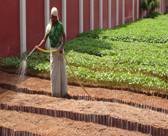 |
|
Watering |
Seedlings |
In general, the water requirement of the species is low. The crop requires a life irrigation on the third day after field planting. After this, irrigation at an interval of 20 to 25 days may be done based upon need. In general, around 6- 8 irrigations are required per year.
PRUNING
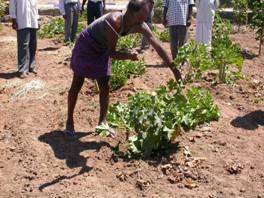 |
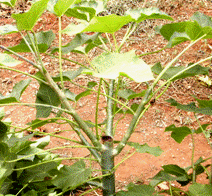 |
First pruning |
Growth after first pruning |
Early pruning at 6 to 8 months after planting or just before flowering is advisable. First pruning must be at 45 cm from ground level which will enhance more number of auxillary branches. Pruning has to be taken up for the first three years to increase number of fruiting branches.
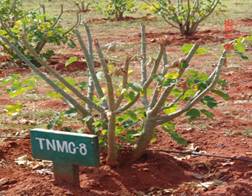 |
 |
Second pruning |
Growth after second pruning |
Second pruning must be made in the newly developed shoots by cutting two thirds of the new flush leaving one third in the plant. Similar procedure has to be followed on the new flush upto the completion of the third year. The pruning operation can be adapted and modified according to the location and also growth and development of the plant. Avoid flowering and seed setting during the first two years in order to develop a broader canopy.
INTERCROPPING
 |
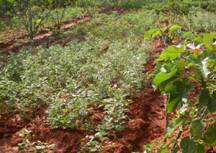 |
Jatropha + Sunflower |
Jatropha + Gingelly |
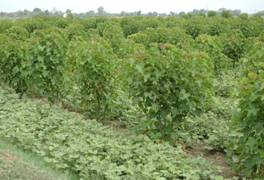 |
 |
Jatropha + Black gram |
Jatropha + Groundnut |
Being a perennial crop, intercrops can be raised in between the rows for the first two years. Crops like tomato, sunflower, ash gourd, bitter gourd, pumpkin, cucumber, cowpea and blackgram can be grown profitably. Among these crops, studies conducted in Tamil Nadu Agricultural University indicated that cow pea was the best intercrop under Jatropha during the initial years.
PEST CONTROL
Factors influencing the occurrence of pests/ diseases
Diseases/pests |
Conducive factors |
Nursery |
|
Damping off |
Heavy seed rate, ill drained heavy soils, presence of decaying organic matter, poor ventilation and poor sunlight. |
Main field |
|
Leaf webber |
During the growth of new flush immediately after rain |
Thrips |
Hot weather |
Scutellerid bugs |
|
Dry root rot |
Dry temperature of 300 C and above, prolonged dry season followed by irrigation. |
Leaf spot |
Temperature is 25- 300 C with relative humidity of above 80 %. |
Integrated disease management strategies
A. Seed : Seed treatment with Pseudomonas fluorescens @10g/kg
of seed.
B. Nursery : Raised seed bed has to be prepared, away from shady
and well drained soils.
C. Main Field : Soil application of Trichoderma viride or Pseudomonas
fluorescence @2.5 kg/ha mixed with 50Kg of FYM,
before planting.
Need based application
Spray Bt @ 1g/litre or neem oil (2%) or monocrotophos36 WSC @1.25 ml/litre or profenophos 50 EC (1ml/litre) for leaf webber.
Control
Spray Methyl Parathion 25 EC @ 2ml/litre or dimethoate 30 EC @2ml/litre or monocrotophos 36 WSC @ 1.25 ml/litre for thrips.
Scutellerid bugs
This pest can be controlled by spraying carbosulfan 25 EC @ 1ml/litre
Root rot management
Root rot may become a problem in the beginning and be controlled by application of 1% of Bordeaux drenching or application of neem cake @ 150 kg /ha.
POST HARVEST MANAGEMENT
The fruits are harvested after change of colour of capsule from yellow to brown and shrinking of fruit capsules for easy dehusking.
i) Thrashing by Manual separation by beating
ii) Mechanical separation using decorticator
Seeds can be shade dried and stored in gunny bags at room temperature.
Yield
Rainfed 3rd year 500 kg/ha
6th year 1250 kg/ha
Irrigated 1st year 2100 kg/ha

© 2008-10 TNAU. All Rights Reserved.